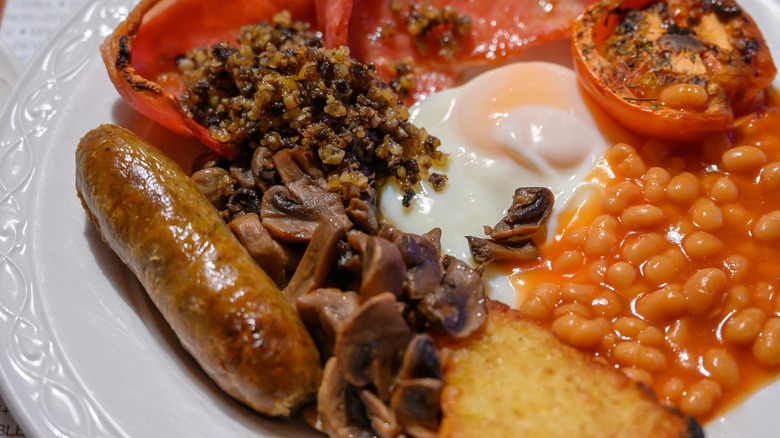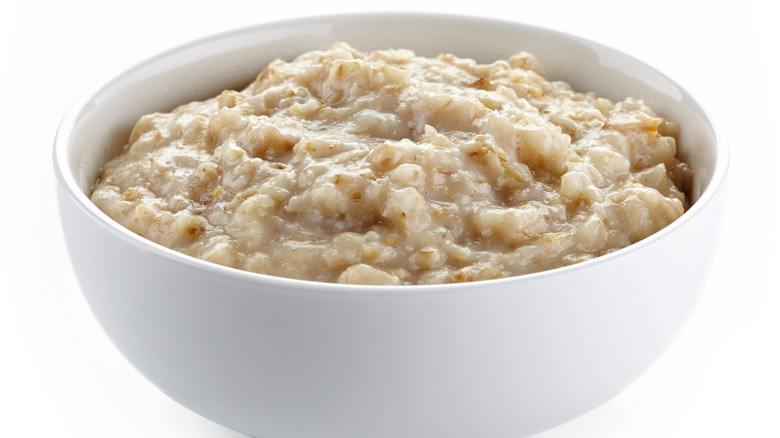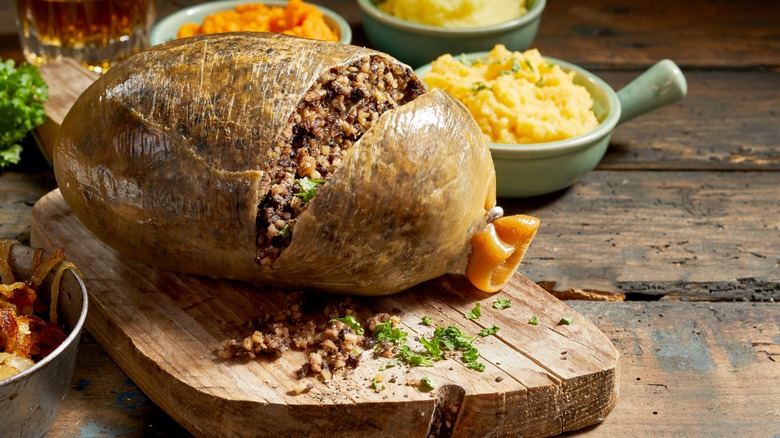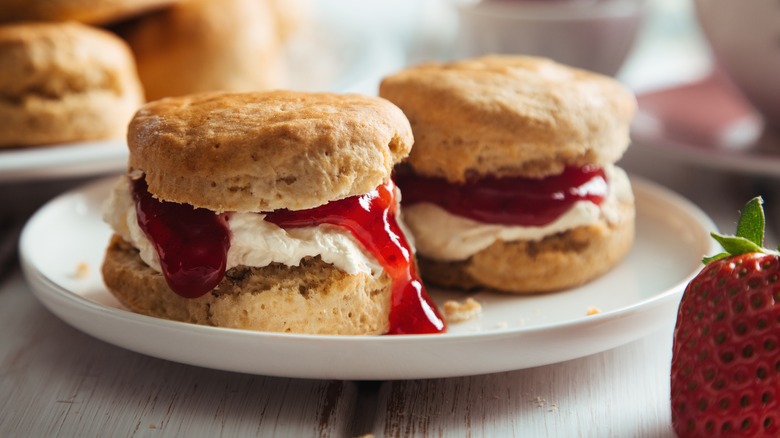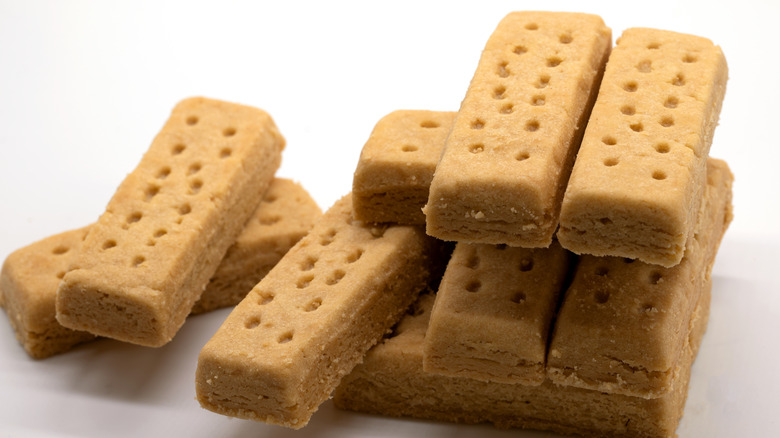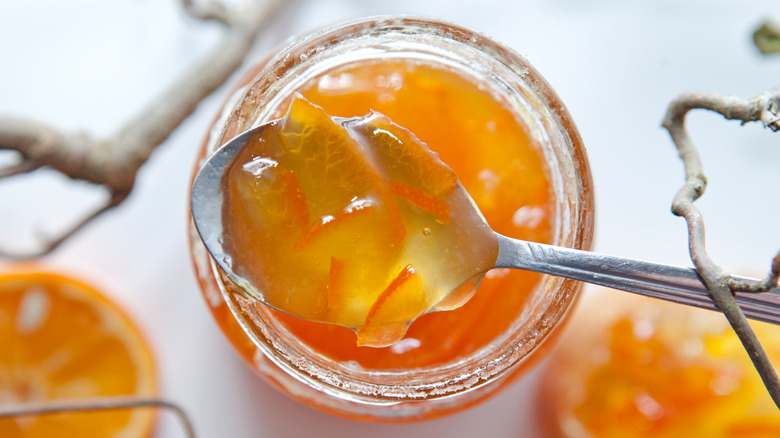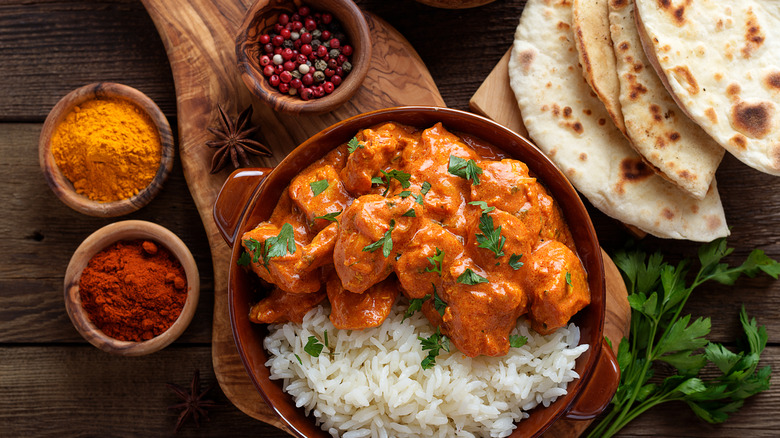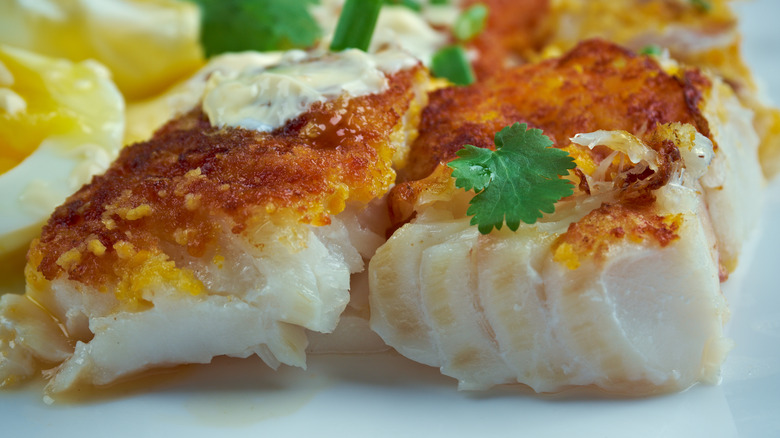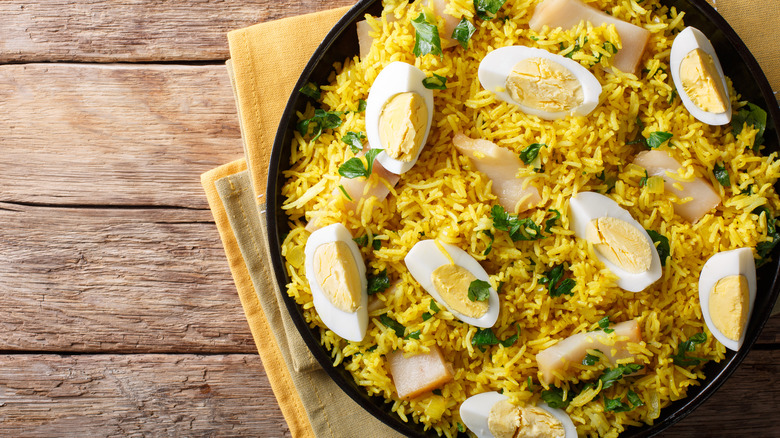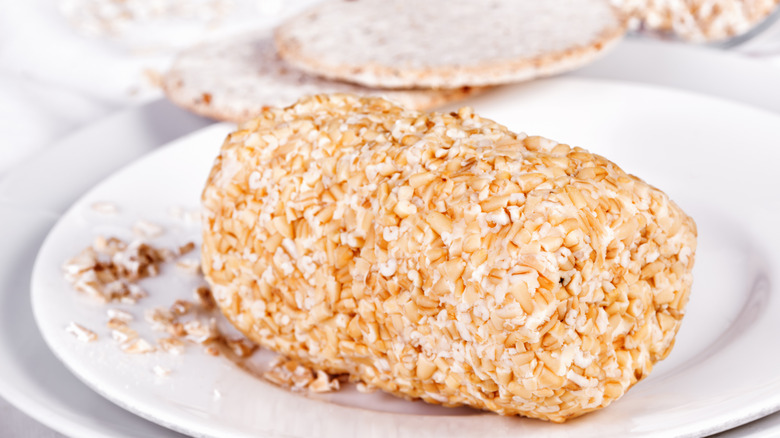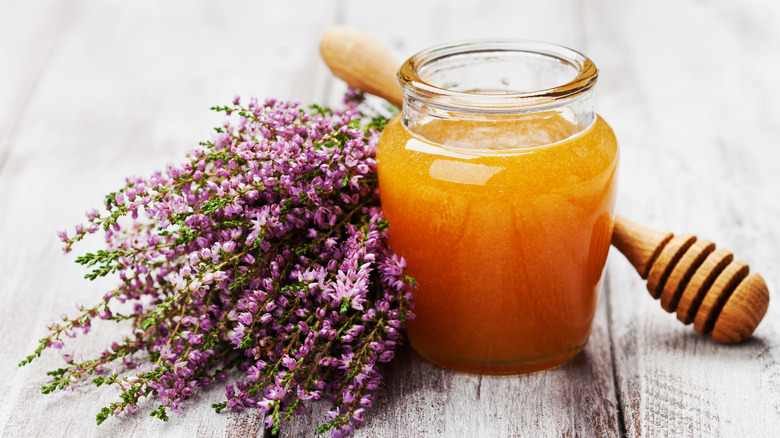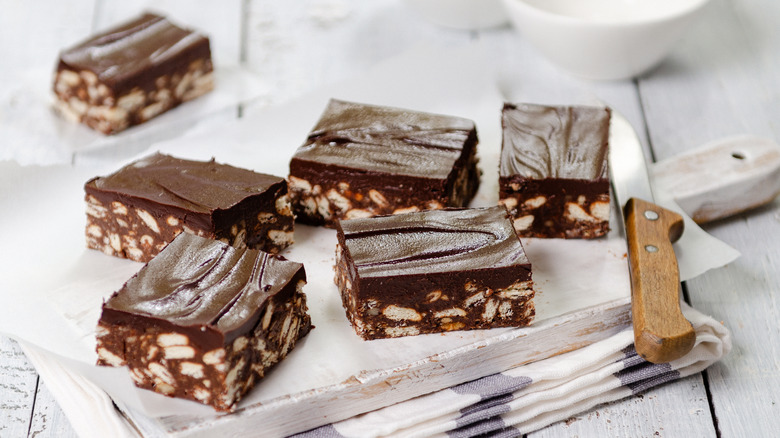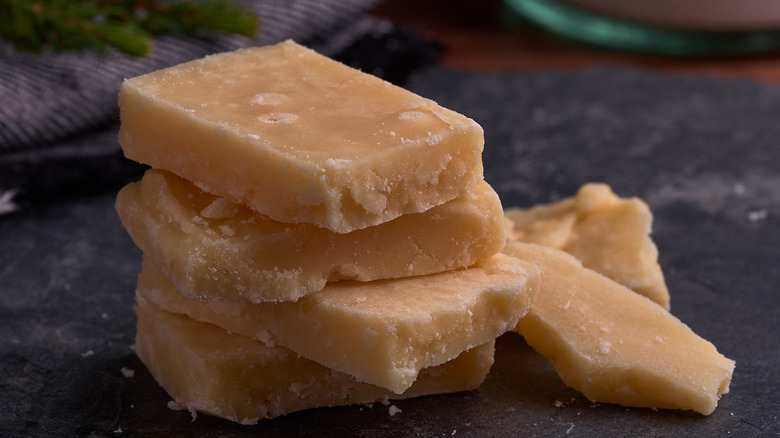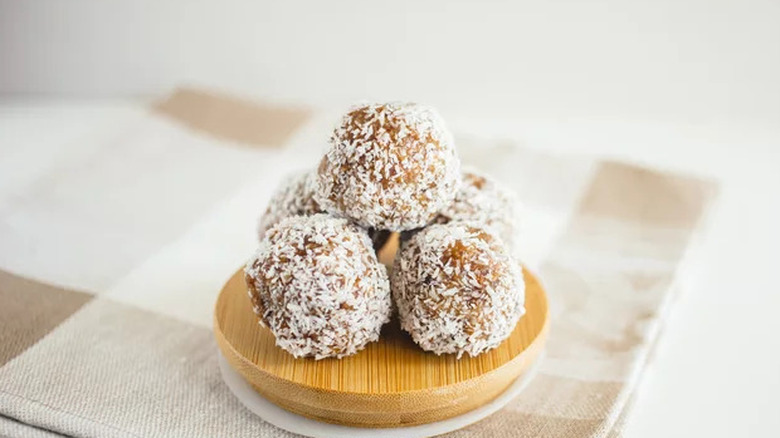13 Notable Foods That Originated In Scotland
What comes to mind when you think of Scottish food? A full Scottish breakfast platter with sausage and beans? A warm bowl of oatmeal? Deep-fried Mars bars?
If you're thinking of Scotch eggs, those are unfortunately not from Scotland, according to The Daily Record. But what about "Great Britain's favorite curry" or Queen Elizabeth II's favorite cake? We've considered the foods that have historical origins linking them to Scotland. Some have been part of Scottish cuisine for centuries, others for only a few decades. Some are purely Scottish inventions, while others came into their modern form on Scottish soil. All of them have, over time, found their place in the Scottish diet and identity.
Take the example of the oat, which, per National Geographic, was introduced to Scotland in the first millennium but became widespread because it grew better than other grains in the cool, damp climate. By the 18th century, oats had become so strongly associated with Scotland that English writer Samuel Johnson mockingly defined oats in his dictionary as "a grain, which in England is generally given to horses, but in Scotland supports the people." Harper's Magazine reports the proud reply of Scotsman James Boswell: "Aye, and that's why England has such fine horses, and Scotland such fine people." The food of Scotland demonstrates how changes in cuisine reflect changes in society and how the diet that sustains a people becomes a part of who they are.
Oatmeal porridge
In "Scotland: A Very Peculiar History" (2011), Fiona MacDonald reports the discovery of ancient traces of barley porridge made with milk in Scotland's Outer Hebrides islands, dating from the 5th century BC. After the introduction of oats to Scotland around 600 AD, ground, dried oats were used to make porridge just as other grains had been used in previous centuries. (oatmeal)
Through porridge, oatmeal is made into a still-beloved and essential part of Scottish cuisine. Scottish newspaper The Press and Journal describes some of the traditions that have formed around oatmeal, such as the old belief that it must be eaten standing up as a sign of respect, and always stirred clockwise, following the path of the sun, using a wooden Scottish utensil called a spurtle. Porridge was once poured into a "porridge drawer" in Scottish kitchens, allowed to set, and cut into portable slices to last the week. Early Scottish universities had a holiday called Meal Monday, defined by Dictionaries of the Scots Language as a long weekend when students returned home for sacks of oatmeal to replenish their food supplies.
Haggis
Today haggis — a hearty, savory pudding of minced sheep organ meat, oats, and onion cooked inside the sheep's stomach — is often considered Scotland's national dish. Scottish national poet Robert Burns famously hailed the haggis as "great chieftain o' the pudding race," and it's the key food served on Burns Night, the suppers eaten on January 25th in his memory. Although this style of meat preparation is an ancient one, haggis didn't become associated with Scotland until surprisingly recently, according to History Today.
In the Medieval era, haggis and other dishes made with offal, such as black pudding, were enjoyed in both England and Scotland without specific cultural associations. This began to change in the late 17th century when Scotland experienced economic decline while England's economy prospered. Scots continued to eat offal out of necessity, but with wider access to choice cuts of meat in England, offal fell out of fashion there. At the same time, political tensions between England and Scotland led the English to deride offal-based dishes like haggis, and by extension, the people who ate them, as crude and uncivilized (this was the era of Samuel Johnson's jape about oats being fit only for horses). Scottish patriots subsequently adopted the insult of being called haggis-eaters as a badge of pride and a sign of their strength and tenacity, including in Burns's aforementioned "Address to a Haggis," composed in 1786. By the 19th century, haggis was firmly a part of Scottish national identity.
Scones
In 1513, Gavin Douglas translated an ancient bread as flowr sconnys (flour scones) in his Scots translation of the Roman "Aeneid." Merriam-Webster dictionary cites that year as the earliest written appearance of the word, demonstrating that scones were familiar to a 16th-century Scottish audience. As described by Freshways, the original scones were large, round, flat cakes cooked on a griddle and served in slices, similar to another dish called bannock.
"The Complete Glossary of the Poetry of Robert Burns," says that a scone is thinner than a bannock and made with various ingredients like potatoes (potato pancakes called "tattie scones" are still served for Scottish breakfast), while bannock is always made with oats. Bannocks and scones had diverged further by the early 20th century, according to a 1929 source quoted in "The British Baking Book," which defines bannocks as large rounds and scones as small rounds.
This same source provides an "old method" and a "modern method" for making scones, with the modern method including baking powder. As home baking and leaveners like baking powder became more widely accessible, scones evolved into their modern form, becoming smaller, lighter, sweeter, and flakier from adding butter and being baked in an enclosed oven. "The British Baking Book" suggests Scottish Gaelic sgonn, meaning a lump, as the origin of the word scone, but others connect it to German or Dutch, or even the Scottish city of Scone, where kings were once crowned.
Shortbread
You might picture Scottish shortbread as a dense, crumbly confection made with just flour, sugar, and butter, but it derives from hard Medieval "biscuit bread" made from leftover bread dough dried in a low oven, according to History UK; the yeast in the bread dough was later replaced with butter, indicated by the name "short" (via The Chicago Tribune).
Shortbread is believed to have been refined by French influence, likely during the Auld Alliance (14th to 16th centuries) when Scotland and France united in friendship against a common enemy (England). The Telegraph reports that some of this French influence may have come to Scotland with the court of Mary, Queen of Scots, in 1561, when she returned to her home country from her youth in France. Mary herself was reportedly especially fond of caraway-seed shortbread in the triangular.
Shortbread was originally a luxury prepared only for special occasions. It is still a traditional food for Scottish New Year celebrations (Hogmanay), as described in The Keene Sentinel. In some regions of Scotland, weddings once included the baking of a special shortbread called the "bride's bonn" by the bride's mother, which was broken over the bride's head as she entered the marital home for the first time (via "Food and Celebration").
Breakfast marmalade
According to the The Age, in Scotland, people first consumed marmalade as a breakfast spread, a custom that didn't catch on in the rest of Great Britain until the late 19th century. Before that, marmalade was eaten as a sweet or an after-dinner digestif.
Let's Look Again, which documents the history of commercial brands in Britain, describes how James Keiller of Dundee, Scotland took over his mother Janet's modest marmalade shop in 1797 and established Britain's first commercial marmalade brand. This was also the first marmalade to include thinly-sliced orange peel. Believed to further aid digestion, orange peel adds pectin to marmalade, allowing it to set without an additional thickener. Keiller's operation grew to become the world's leading marmalade manufacturer in the 19th century.
Still available today, Keiller's has become iconic with the origin story supposing that the Kieller's product was made initially to use up a discounted cache of past-their-prime oranges purchased from a Spanish cargo ship (via Undiscovered Scotland). But, a quince marmalade originated in Portugal and had been known in Britain for centuries before the Keillers, for example, as a favorite treat of Anne Boelyn (though another colorful bit of lore connecting the name marmalade to Mary, Queen of Scots is false, debunked by The Tudor Travel Guide).
Chicken tikka masala
Around the world, immigrant chefs serving food from their home countries create new recipes from traditional ones, substituting ingredients and adjusting to local tastes. The BBC describes how Pakistani-born Ali Ahmed Aslam, owner of the Shish Mahal restaurant in Glasgow, Scotland, made just such an innovation in the 1970s after a customer asked for a sauce with his chicken tikka, a grilled meat dish traditionally served dry. Aslam added a creamy tomato-based dressing with mild heat to reflect his customer's preference.
He called the new dish chicken tikka masala, masala being the term used in the Indian subcontinent for a spice mixture (either dry spices or, as in this case, a paste that forms the base of a sauce). Aslam's invention quickly caught on and began appearing on the menus of other restaurants. Born of ingenuity and adaptability, chicken tikka masala has long been recognized as the most popular curry in Britain alongside other staples like butter chicken; though, as detailed in a recent study by the takeaway app Foodhub, hotter curries have been increasing in popularity as tastes and populations change.
Finnan Haddie
As reported in Atlas Obscura, Scots may have begun using smoke to preserve fish in the Middle Ages after the technique's introduction by the Vikings. Scottish fishermen subsequently produced unique local smoked fish varieties such as Finnan haddie from Findon (Finnan), Aberdeenshire, made from haddock, a North Atlantic cod.
Finnan haddie is especially prized for its light, delicate flavor and texture, which comes from its being processed minimally: the original Finnan haddie could be enjoyed just 12 hours after the fish was caught, according to a 19th-century travelogue. But a short smoking time of 8 to 9 hours resulted in a short shelf-life. Though Finnan haddie first appears in literature in 1643, in a book by Gilbert Blakhal, it was largely unknown outside of Scotland until the 1840s, when a new railway connecting Aberdeen to London allowed the fish to be shipped before it spoiled (via Northern Producers Association).
The difficulty of obtaining real Finnan haddie before modern transport resulted in imitation products, described in a 19th-century guide to Aberdeen as being "of the most deleterious tendency." Even today, fish is artificially smoked in factories and dyed to mimic the yellowish color of real Finnan haddie, which is smoked over green wood and peat. Finnan haddie may be roasted, grilled, or poached in milk. Traditionally enjoyed for breakfast, it is a key ingredient in Scottish dishes like Cullen skink (a creamy chowder) and the rice dish kedgeree.
Kedgeree
The ingredients that comprise kedgeree may not seem particularly Scottish (rice, herbs, boiled eggs, curry powder) until we come to the dish's key traditional component: flakes of smoked Finnan haddie. History Today describes how kedgeree developed from the Anglo-Indian fusion cuisine of British India. Indian cooks working in British households altered traditional recipes to suit their employers' tastes. When those employers returned to Britain with a newfound appreciation for Indian food (albeit modified), they helped popularize Indian flavors and ingredients.
The Economist notes khichdi, a mixture of rice and lentils prepared in various ways throughout the Indian subcontinent, as the original form of kedgeree. Soft and mild khichdi was adopted as a breakfast dish by Anglo-Indian households in place of oatmeal. Khichdi served for breakfast alongside smoked fish developed into mixed rice made with smoked fish, and when this was later recreated in Scotland, lentils were subtracted, and Finnan haddie added. The earliest-known recipe for kedgeree, written in 1790, contains no spices except cayenne pepper, but curry powder was becoming popular in Britain at that time and is found in most modern kedgeree recipes (via Food52).
Caboc and Crowdie
When we recall that the ancient porridge found in Orkney was cooked in milk, it's no surprise that Scotland has a long tradition of cheesemaking. Cheese was so important to the traditional Scottish diet it was once called "white meat," according to an article by the Society of Dairy Technology, which describes some of the oldest cheese varieties in Scotland as crowdie and caboc.
"A Cheesemonger's History of the British Isles" details their production: both crowdie and caboc are soft, fresh (un-aged) cheeses, but while crowdie is made from the curds in naturally-soured milk, caboc is made from cream and rolled in Scotland's ubiquitous oats. Rich, fatty caboc was traditionally a luxury (per Cheese Hub), while crowdie was an everyday cheese, often made with the skimmed milk from caboc making. Both may be eaten with oatcakes or bread, and crowdie is combined with berries, oats, and whiskey to make the parfait-like dessert cranachan.
Scottish cheesemaking declined after World War II but was given new life in 1962, when Susannah Stone of the village of Tain was encouraged to commercialize her home cheesemaking and founded Highland Fine Cheeses, still in operation (via Highland Fine Cheeses). The Teddington Cheese Catalogue claims that Stone's skills are a legacy of her ancestor Mariota de Ile, a 15th-century chieftain's daughter who took refuge from an arranged marriage in an Irish convent, where she learned cheesemaking that she passed down to her female descendants.
Heather Honey
The moors of Scotland are famous for their abundant heather flowers, and just as renowned is heather honey, sometimes said to be the finest type of honey in the world. There's no other honey quite like it: Honey Traveler describes its mild sweetness and complex flavor to be fragrant, earthy, and smoky.
Heather honey also has unusual chemical properties noted in Atlas Obscura, being thixotropic, which means it's a semisolid jelly at rest and becomes liquid when shaken or stirred, like a solution of cornstarch and water. This makes the honey difficult to extract, so it's typically sold in the comb, although beekeepers have developed a technique for extracting by spinning the frames in which the bees deposit their honey, shaking the mixture around enough that it can be poured. Heather honey is difficult to produce in the first place, as beehives must be moved to the moors during the heather's brief flowering season in August.
Aside from its other unique qualities, heather honey is notably high in certain nutrients, containing up to 10 times more manganese than other honey. But heather honey was not always so highly-regarded. In his "Materia Medica," the first-century medical and botanical writer Dioscorides wrote the following of heather, which he called ereika: "the bees use [the flowers], but they make honey with it that is not good."
Tiffin
Another dish connected to Anglo-Indian cuisine and the British Empire's presence in India is the Scottish dessert tiffin. A typical chocolate tiffin recipe is a no-bake icebox cake made from chocolate poured over crumbled biscuits (cookies) and chilled until it sets. The word tiffin, according to the OED, derives from 18th-century English tiffing, which meant to take a small sip. This word was used for a light meal served with something to drink, as in the British custom of afternoon tea, and eventually became applied not to the occasion but the type of cake you might serve then. In India, tiffin has taken on a different but related meaning: a light midday meal and, in some parts of the country, a packed lunch or the lunchbox itself.
Also known by descriptive names like chocolate biscuit cake, the Scottish tiffin is said to have been invented in the early 1900s in the city of Troon, though its precise origins are unknown. The late Queen Elizabeth II favored a balanced diet, but when she did indulge, crunchy, chocolatey tiffin was her favorite cake. Today reports that whenever her chefs prepared tiffin, the queen would eat it gradually until it was all gone, even having the leftovers brought with her when she traveled by train.
Tablet
Scottish sweet tablet is a confection often compared with classic fudge recipes, although it has a coarser, more grainy texture and a slightly harder consistency that melts in your mouth. The first-known recipe for tablets, which appears in "The Household Book of Lady Grizel Baillie" from the early 18th century, uses just cream and sugar. As cream burns easily, later recipes replaced it with condensed milk and butter, and some modern recipes also add chopped nuts and flavorings like vanilla. This mixture is heated over the stove to what candy-makers call the "soft ball stage," then poured and allowed to set.
Sugar manufacturer Ragus reports that during the colonial era, raw sugarcane from Britain's colonies in the Caribbean was shipped to refineries in Scotland. Scotland's role in the sugar industry led to sugar becoming an important part of the Scottish diet; even today, Scotland consumes more sugar than other parts of the UK. This led, naturally, to the development of a strong tradition of Scottish sweets and candies, once made in large batches at home and sold on the street by women known as "Sweetie Wives."
Scottish Macaroons
Another unique product of the region's sweets tradition is Scotland's unique macaroon, made from a creamy, smooth fondant covered in chocolate and coconut flakes. Not to be confused with French macarons, Scottish macaroons bear a closer resemblance to European and American macaroon cookies, also often made with coconut. However, the fondant base for Scottish macaroons contains an unlikely ingredient: mashed potato!
Insider Co. UK credits Scottish candy maker John Justice Lees with inventing the potato macaroon in the 1930s. Legend claims that Lees added leftover mashed potatoes to the recipe by accident, but in reality, Lees tried a lot of different ingredients before settling on potatoes as part of his experiments in creating a perfectly smooth chocolate fondant bar for his company to sell.
The starchy potato provides structure and texture to the fondant, but the final result has no noticeable potato flavor, and you shouldn't use leftover mashed potatoes to make them anyway, as the potato must be unseasoned. Lees's company, Lees of Scotland, is still in operation, and the macaroon bar, along with the tablet, is one of its signature items.
